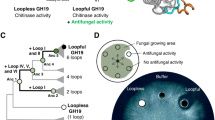Abstract
We have cloned a gene involved in starch metabolism that was identified by the ability of its product to bind to potato starch granules. Reduction in the protein level of transgenic potatoes leads to a reduction in the phosphate content of the starch. The complementary result is obtained when the protein is expressed in Escherichia coli, as this leads to an increased phosphate content of the glycogen. It is possible that this protein is responsible for the incorporation of phosphate into starch-like glucans, a process that is not understood at the biochemical level. The reduced phosphate content in potato starch has some secondary effects on its degradability, as the respective plants show a starch excess phenotype in leaves and a reduction in cold-sweetening in tubers.
This is a preview of subscription content, access via your institution
Access options
Subscribe to this journal
Receive 12 print issues and online access
$209.00 per year
only $17.42 per issue
Buy this article
- Purchase on Springer Link
- Instant access to full article PDF
Prices may be subject to local taxes which are calculated during checkout
Similar content being viewed by others
References
Smith, A.M., Denyer, K., and Martin, C. 1997. The synthesis of the starch granule. Annual Review of Plant Physiology and Plant Molecular Biology 48: 67–87.
Ball, S., Guan, H.-P., James, M. Myers, A., Keeling, P., Mouille, G., et al. 1996. From glycogen to amylopectin: a model explaining the biogenesis of the plant starch granule. Cell 86: 349–352.
Jane, J., Kasemsuwan, T., Chen, J.F., and Juliano, B.O. 1996. Phosphorus in rice and other starches. Cereal Foods World 41: 827–832.
Robinson, K.A. and Schreier, H.J. 1994. Isolation, sequence and characterization of the maltose-regulated mlrA gene from the hyperthermophilic archaeum Pyrococcus furiosus. Gene 151: 173–176.
Bay-Smidt, A.M., Wischmann, B.,, Olsen, C.E. and Nielsen, T.H. 1994. Starch bound phosphate in potato as studied by a simple method for determination of organic phosphate and 31P-NMR. Starch/Stärke 46: 167–172.
Swinkels, J.J.M. 1985. Composition and properties of commercial native starches. Starch/Stärke 37:1–5.
Duwenig, E. Untersuchungen zur Funktion von α-1,4-Glucan-Phosphorylasen in höheren Pflanzen. (PhD thesis, University Potsdam, Germany, 1996).
Ho, L.C. 1988. Metabolism and compartmentation of imported sugars in sink organs in relation to sink strength. Annual Review of Plant Physiology and Plant Molecular Biology 39:355–378.
Trethewey, R.N. and ap Rees, T. 1994. A mutant of Arabidopsis thaliana lacking the ability to transport glucose across the chloroplast envelope. Biochem. J. 301: 449–454.
Müller-Thurgau, H., 1882. Ueber Zuckeranhäufung in Pflanzenteilen in Folge Niederer Temperatur. Landwirtschaftliche Jahrbücher 11: 751–828.
Kossmann, J., Visser, R.G.F., Müller-Röber, B., Willmitzer, L., and Sonnewald, U. 1991. Cloning and expression analysis of a potato cDNA that encodes branching enzyme: evidence for co-expression of starch biosynthetic genes. Mol. Gen. Genet. 230:39–44.
Höfgen, R. and Willmitzer, L. 1990. Biochemical and genetic analysis of different patatin isoforms expressed in various organs of potato (Solanum tuberosum L.). Plant Sci. 66:221–230.
Rocha-Sosa, M., Sonnewald, U., Frommer, W., Stratmann, M., Schell, J., and Willmitzer, L. 1989. Both developmental and metabolic signals activate the promoter of the class I patatin gene. EMBO J. 8: 23–29.
Logemann, J., Schell, J., and Willmitzer, L. 1987. Improved method for the isolation of RNA from plant tissue. Anal. Biochem. 163:16–20.
Lehrach, H., Diamond, D., Wozney, J.M. and Boedtker, H. 1977. RNA molecular weight determinations by gel electrophoresis under denaturing conditions, a critical reexamination. Biochemistry 16: 4743–4751.
Amasino, R.M. 1986. Acceleration of nucleic acid hybridization rate by polyethylene glycol. Anal. Biochem. 152: 304–307.
Laemmli, U.K. 1970. Cleavage of structural proteins during the assembly of the head of bacteriophage T4. Nature 227:680–685.
Müller-Röber, B.T., Kossmann, J., Hannah, L.C., Willmitzer, L., and Sonnewald, U. 1990. One of two different ADP-glucose pyrophosphorylase genes from potato responds strongly to elevated levels of sucrose. Mol. Gen. Genet. 224:136–146.
Nielsen, T.H., Wischmann, B., Enevoldsen, K., and Møller, B.L. 1994. Starch phosphorylation in potato tuber proceeds concurrently with de novo biosynthesis of starch. Plant Physiol. 105: 111–117.
Ames, B.N. 1966. Assay of inorganic phosphate, total phosphate and phos-phatases. Methods Enzymol. 8: 115–118.
Author information
Authors and Affiliations
Corresponding author
Rights and permissions
About this article
Cite this article
Lorberth, R., Ritte, G., Willmitzer, L. et al. Inhibition of a starch-granule–bound protein leads to modified starch and repression of cold sweetening. Nat Biotechnol 16, 473–477 (1998). https://doi.org/10.1038/nbt0598-473
Received:
Accepted:
Issue Date:
DOI: https://doi.org/10.1038/nbt0598-473
This article is cited by
-
Allelic variation for alpha-Glucan Water Dikinase is associated with starch phosphate content in tetraploid potato
Plant Molecular Biology (2022)
-
Can gene editing reduce postharvest waste and loss of fruit, vegetables, and ornamentals?
Horticulture Research (2021)
-
Mutations in Glucan, Water Dikinase Affect Starch Degradation and Gametophore Development in the Moss Physcomitrella patens
Scientific Reports (2019)
-
Alpha-Glucan, Water Dikinase 1 Affects Starch Metabolism and Storage Root Growth in Cassava (Manihot esculenta Crantz)
Scientific Reports (2017)
-
Starch phosphorylation: insights and perspectives
Cellular and Molecular Life Sciences (2016)



